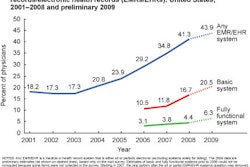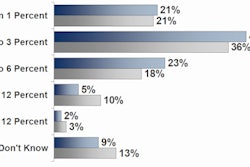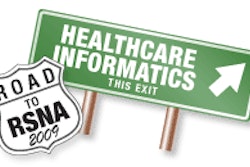With sufficient planning, a radiology department in a large, busy urban hospital can successfully adopt speech recognition to dictate and self-edit radiology reports -- and achieve a dramatic improvement in report turnaround times.
These are impressive statements published online in an article in the British Journal of Radiology (March 11, 2010) from the two largest hospitals in London's Imperial College Healthcare NHS Trust. But the imaging departments of Hammersmith Hospital and Charing Cross Hospital have established a strong reputation for radiology IT innovation. In the mid-1990s, Hammersmith Hospital was the first large hospital in the world to implement a hospital-wide PACS. The two hospitals adopted a shared RIS and PACS in 2003.
Consultant radiologists working in the imaging departments of the two hospitals went "cold turkey" when speech recognition technology was implemented in December 2004 (PowerScribe V.3, Dictaphone Healthcare Solutions, Nuance Communications, Burlington, MA). It became the sole method of reporting from the day it was introduced.
Speech recognition reporting was implemented to reduce the significant delay between the time it took to dictate a report and the time that a typed report appeared in the PACS (GE Healthcare, Chalfont St. Giles, U.K.). The hospitals used nine stenographers to transcribe and type the reports, but they were unable to keep up with the volume in a timely manner, according to lead author Dr. Jonathan L. Hart, a consultant radiologist at Charing Cross Hospital.
The problem was exacerbated by the fact that most of the secretarial staff who typed the reports were temporary personnel and had little or no medical knowledge, explained co-author Alan McBride, senior systems analyst at Hammersmith Hospital. This necessitated that radiologists read the transcribed reports very carefully, often making corrections two to three times. Hiring and retaining a sufficient number of well-trained radiological secretaries was not possible, the authors wrote.
Radiology reports were accessible in dictated format on tape for Hammersmith physicians, but not so for physicians at Charing Cross until the typed reports were placed on the RIS/PACS network.
What they did
Recognizing that implementations that were rushed or not carefully planned often resulted in failure, or less than efficient use, the two imaging departments began an extensive planning process for full integration of the speech recognition system selected with the PACS on the desktop. The hospitals required that when an unreported exam was opened on the PACS with a single mouse click, all demographic data populate automatically to the report.
Members of the imaging departments were involved early in the planning stage, including radiologists, radiographers, management, and secretarial staff, as well as representatives from the IT department. This inclusive, organization-wide approach encouraged acceptance of the technology and willingness to make its adoption a success.
The implementation team consisted of engineers from RIS, PACS, and speech recognition vendors, hospital IT staff, and a radiologist. They used a standalone computer and PACS to perform extensive prelaunch testing and troubleshooting using dummy studies, which included historical examinations on the same test patients. All possible reporting scenarios were simulated, and problems were worked out of the system as much as possible in advance.
The implementation date was selected just before the Christmas holiday, a time when the number of imaging procedures performed is typically reduced. Radiologists and staff were trained the week before implementation. Training was supplemented by onsite application trainers during the launch week.
Radiologists were required to self-edit and electronically sign reports immediately after dictation. "Reducing the number of workflow steps places the radiologist in control of the entire process, and the short time invested in proofreading and making brief corrections to the speech recognition text is offset by significant reduction in interruptions from clinical staff seeking reports on studies that have been dictated but not typed or authorized," the authors wrote.
Radiologists were also encouraged to develop standardized report templates and macros for both normal exams and more complex imaging reports, such as cardiac MRI exams.
Measuring success
To evaluate the impact of speech recognition technology on turnaround times, data were collected starting January 2004 through February 2006 from the hospitals' RIS database (CRIS, Healthcare Software Systems, Nottinghamshire, U.K.). Data about all of the exams performed in the departments were included. Monthly mean reporting times and completion times were established in categories for emergency patients, inpatients, outpatients, or referred by general practitioners.
The team found the improvement in turnaround times due to speech recognition to be "dramatic." In 2004, emergency department and primary care reports took three to five days to complete at Hammersmith Hospital. In August 2004, inpatient and outpatient reports took from three to eight days. At Charing Cross Hospital, the turnaround time was even worse: Emergency department and primary care reports took five to seven days to complete, and inpatient and outpatient reports took from seven to 11 days, Hart reported.
From January 2005 to February 2006, emergency imaging procedures were reported promptly, with 95% reported within 24 hours. Actual improvements in turnaround time could be even greater, but the hospitals' reporting systems aren't able to measure turnaround times faster than one day.
How accurate are the reports? A formal evaluation has not been conducted, but the authors stated that, in their experience, the majority of reports require little or no alteration.
By Cynthia E. Keen
AuntMinnie.com staff writer
March 19, 2010
Related Reading
'Send to editor' speech recognition function boosts radiologist productivity, December 1, 2009
Individual factors affect gains from speech recognition, June 19, 2007
Speech recognition cuts report turnaround times, May 4, 2007
RIS-SR-PACS combo speeds radiology reporting, April 17, 2007
Speech recognition technology shows double-digit error rate, November 30, 2006
Copyright © 2010 AuntMinnie.com



















